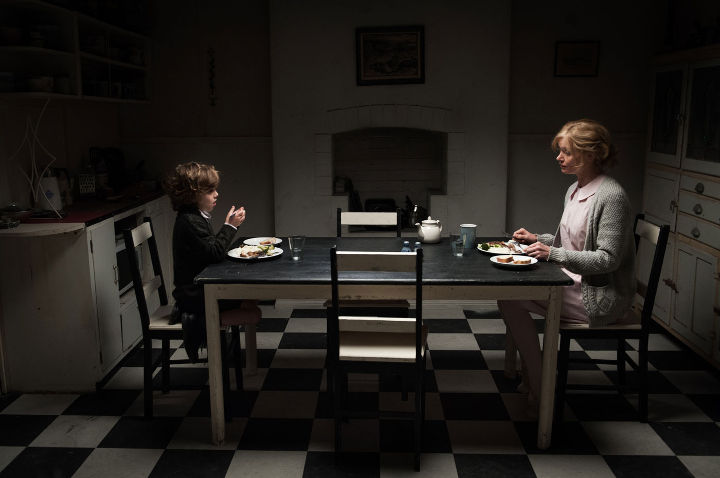
As a tool for examining serious issues, horror movies are sorely neglected. For every film with something to say, there are a hundred cheap knock-offs of tired old formulas. Every so often, something needs to come along and breathe life back into the genre. Perhaps the most painful trend in recent years was started by Paranormal Activity back in 2007, which began a slew of movies that do nothing more than jump out at you and say boo in increasingly predictable ways. Suspense appeared to be in danger of becoming a forgotten art in horror cinema.
The Babadook may only be Jennifer Kent’s first film, but it may be the most memorable debut in the last five years. It stands in stark contrast not only to the recent ‘cattle-prod’ horror films, but also with older and more venerable slasher and monster movies. The film examines a fraught relationship between mother and son which is both uncompromising and entirely believable. With deep and convincing central characters instead of sacrificial lambs, shock moments or other tropes, the Babadook is an entirely different kind of film.
The story revolves around Amelia, a widowed mother and her six-year-old problem child Samuel. After the sudden death of Amelia’s husband in a car crash shortly before Samuel’s birth, the mother and son now occupy the empty and bleak house which the couple used to share. Samuel becomes increasingly withdrawn, and his erratic behaviour starts to isolate Amelia from her friends, who can no longer tolerate it. Samuel also harbours a mortal fear of monsters which he believes live in the darkened corners of the house. His fear translates into neediness, which only puts further pressure on Amelia.
One night things take a turn for the worse when Samuel finds a sinister looking book on the shelf entitled Mr Babadook. The book warns of a monster which lurks in the darkness and possesses its victims. Despite Amelia’s efforts to dissuade him, Samuel insists on reading further and becomes terrified by what he sees. In the following days, Samuel begins to think that he sees the monster everywhere and even starts to blame it for his irrational actions. As Amelia struggles to cope with the situation, she begins to suspect that Samuel may not just be imagining the dark presence in the house.
The film has a unique and haunting visual style. One of the best examples is the pop-up book used to introduce the Babadook. Hinting at unseen evils using children’s books and illustrations is a horror trope that’s as old as the hills. However, the moment when the already sinister-looking book’s contents start to become clear - a tiny claw-like hand swipes out from behind a foreboding paper door - was distinctly chilling. The Babadook’s particular brand of fear has earned it much criticism in some circles. Instead of a string of crescendo-like scares, there is a constant aura of dread throughout, which gradually increases as the story nears its climax.
Essie Davis’s performance as Amelia is surely the most memorable thing about this film. Her portrayal of the character as simultaneously sweet and caring, yet on the brink of being torn apart by hatred and resentment that she can’t control, is extremely powerful and convincing. Much of the tension which permeates the film stems from the way that we see her psyche slowly crumbling in front of our eyes. Noah Wiseman is still very young but in playing Samuel, he gives a compelling impression of the boy’s inexpressible inner turmoil. The on-screen relationship between parent and child is shown without compromise; a far cry from the standard sugar-coated visions of parenthood. The monster which gives the film its name is equally striking, moreso for the short time that it actually spends on screen.
It’s a very tired trope by now to give glimpses of a monster through children’s pictures or writing. The Babadook neatly subverts the cliches by using a beautifully illustrated pop-up book instead. The moment when a paper claw flicks out from behind a little card door, confirming the already disturbing looking creature’s malicious intent, is deeply unsettling. The depth of the characters and the unique visual style of this film draw you into its world. The result is something both compelling and frightening.
The later part of the Babadook is unfortunately not its strong point. Many people who disliked the movie intensely said it was too slow-paced and ponderous. The film’s creeping way of inducing fear was bound to disagree with some people but the later part of the film seems to abandon it, at least temporarily. The final section is not enough to spoil everything, but it felt a little misjudged and out of step with the rest of the film.
It’s easy to forget that the Babadook is the director’s first feature, but it becomes more apparent towards the end. Fortunately it’s never enough to drag the rest of the film down. Another stumbling block is that Samuel becomes teeth-grindingly annoying at times. It’s hard to imagine how you would portray a problem child whilst avoiding this effect, but I found that I wasn’t always rooting for his safety throughout the film.
The horror genre recieved a much-needed knock on the head with the release of the Babadook. Whether it becomes part of a trend towards more deep and artistic horror remains to be seen. In any event, the film is essential viewing for any fans of the genres it spans, or anyone who appreciates finely crafted cinema. If you are willing to cast your expectations aside and experience something unique and refreshing, this film will certainly deliver.




